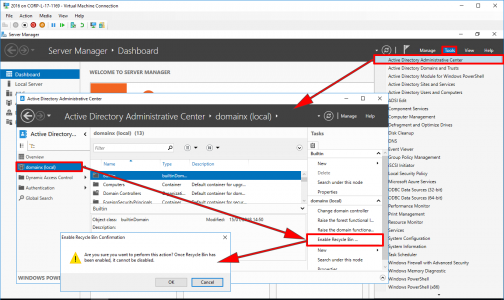Disaster Recovery Planning KB ID 0001911
Problem
When Disaster Recovery Planning for Active Directory (AD) and Entra ID (formerly Azure AD) is vital to ensure the continuity of identity services during failures, cyberattacks, or unforeseen disasters. Below is a structured approach to building a resilient disaster recovery strategy.
Solution: Disaster Recovery Planning
Define Objectives and Scope
Recovery Time Objective (RTO): Determine how quickly AD/Entra ID must be restored.
Recovery Point Objective (RPO): Decide how much data loss is acceptable.
Business Impact Analysis (BIA): Assess dependencies on AD and Entra ID within business operations.
Compliance Requirements: Ensure adherence to relevant standards like ISO 27001, NIST, or GDPR.

Active Directory (AD) Disaster Recovery Planning
Backup and Recovery
System State & Bare Metal Backups:
Back up system state data using Windows Server Backup or third-party tools (e.g., the AD database NTDS.dit).
Ensure backups cover at least two domain controllers per domain.
Securely store backups offline or on an isolated network.
Authoritative vs Non-Authoritative Restore:
Non-Authoritative: Used when other domain controllers are operational.
Authoritative: Restore a specific version or recover deleted objects.
Active Directory Recycle Bin:
Enable this feature for quicker recovery of deleted objects.
Test Restores:
Test recovery processes in a controlled environment to verify their success.
Redundancy and High Availability
Multiple Domain Controllers:
Deploy at least two DCs per site, configured as Global Catalogue Servers.
For remote or low-security locations, use Read-Only Domain Controllers (RODCs).
Active Directory Sites and Services:
Properly configure to optimise authentication and replication.
Regularly check replication health using tools like repadmin.
Time Synchronisation:
Keep domain controllers synced with a reliable NTP source.
Security Hardening
Least Privilege Access:
Implement a tiered administrative model with separate permissions for each level.
Deploy Just-in-Time (JIT) and Just Enough Administration (JEA).
Admin Security Enhancements:
Require Multi-Factor Authentication (MFA) for admin accounts.
Use Privileged Access Workstations (PAWs) for AD management tasks.
Security Information and Event Management (SIEM):
Monitor replication and logins with tools like Microsoft Sentinel or Splunk.
Recovery Procedures
Offline Domain Join (ODJ):
Pre-provision computers for seamless domain joining in emergencies.
Catastrophic Failures:
Restore domain controllers from a trusted backup in an isolated network.
Use Install from Media (IFM) for faster deployments.
Testing and Validation:
Simulate AD failures regularly to ensure recovery processes are sound.
Entra ID (Azure AD) Disaster Recovery Planning
While Entra ID benefits from cloud-based resilience, a backup plan is still necessary.
Backups and Exports
Native Limitations:
Microsoft does not offer traditional backup/restore functions. Export data regularly using Azure AD Connect Export or the Microsoft Graph API.
Third-Party Tools:
Use tools like Quest Recovery Manager or Veeam to back up objects.
Entra ID Recycle Bin:
Recover deleted data (users, groups, and roles) within 30 days.
Disaster Recovery Planning Resiliency and Redundancy
Hybrid Identity Redundancy:
Deploy multiple Azure AD Connect servers in Staging Mode.
Ensure failover for Pass-Through Authentication (PTA) by deploying multiple agents.
Conditional Access:
Maintain break-glass accounts (MFA-protected cloud accounts) for emergency access.
Configure fallback authentication like Password Hash Sync.
Disaster Recovery Planning Continuous Testing
Recovery Tests:
Conduct quarterly drills and failover tests.
Maintain an isolated testing environment.
Security Audits:
Perform penetration testing and red-team exercises to identify weaknesses.
Disaster Recovery Planning Documentation
Maintain clear and up-to-date runbooks for all DR processes.
Automate repetitive tasks using PowerShell or Azure Automation.
Review and revise your disaster recovery plan regularly to keep it current.
Disaster Recovery Planning: Conclusions and Final Thoughts
A solid disaster recovery plan for AD and Entra ID includes:
-
Regular backups and restores.
-
Redundant systems to ensure continuity.
-
Strict security to mitigate risks.
-
Comprehensive testing to validate all recovery processes.
Related Articles, References, Credits, or External Links
NA


